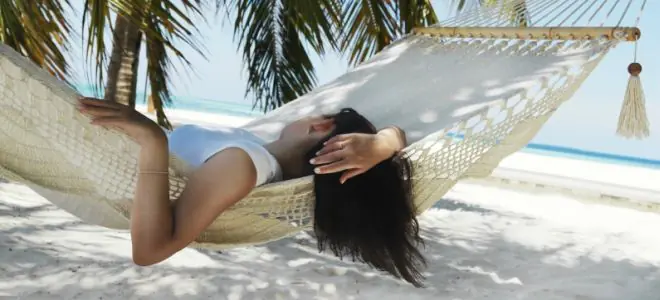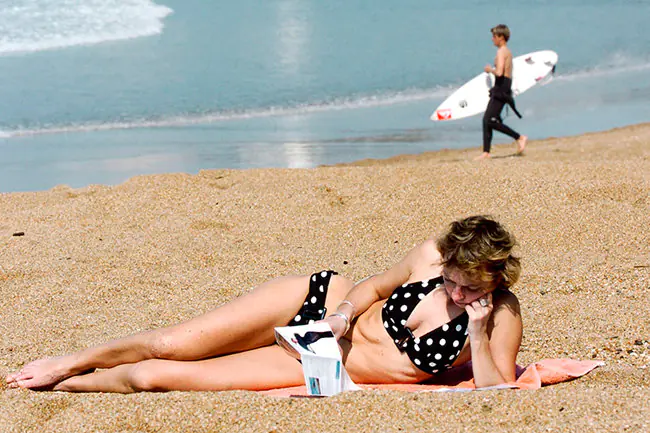
In summer, most women try to achieve an even bronze or chocolate skin tone. But every representative of the fair sex knows very well that it will take a long time to reach her cherished goal, because it is safe to be in direct sunlight only early in the morning and in the evening. In addition, some people are prohibited from contacting ultraviolet radiation at all. Therefore, you should find out in more detail whether it is possible to tan in the shade, and how to do it correctly in order to achieve the desired color of the epidermis.
Does your skin tan in the shade?
To answer this question, you need to understand how exactly a tan forms.
The acquisition of a dark shade by the skin occurs under the influence of ultraviolet rays of 2 types - UVA and UVB.
The first type of radiation is distinguished by its ability to penetrate into the deep layers of the dermis, due to which it loses moisture, elasticity and firmness, and undergoes photoaging processes. In this case, the epidermis quickly becomes bronze or chocolate.
UVB rays ensure the release of vitamin D in the body, which has a beneficial effect on the state of local immunity and protective indicators of the skin, and general well-being.
Both types of solar radiation are radiation that spreads both when under direct rays and when staying in the shadow zone. In the latter case, exposure to UVA rays is reduced. In addition, the produced pigment is more resistant to washing off and remains in the epidermis longer.
Thus, sunbathing in the shade is possible, and even preferable. This allows you to avoid sunburn, reduces the risk of skin cancer and exacerbation of endocrine pathologies. The tan will turn out much more even and beautiful, and will last a long time.
Is it possible to sunbathe in the shade under an umbrella at sea?
Being near any body of water, especially large ones like the ocean or sea, the likelihood of getting tanned quickly is quite high. The fact is that solar radiation is well reflected from the surface of the water and even from the ground, sand and pebbles.
Considering the above information confirming the spread of ultraviolet rays regardless of the presence of shade, we can conclude that it is quite possible not only to tan under an umbrella or canopy on the beach, but also to burn. Solar radiation penetrates everywhere, especially since it is difficult to spend the whole day in the shadow zone; in any case, a person goes to take a dip in the water several times. Therefore, even if you spend all your time under an umbrella, you must always use special sunscreens. At the beginning of your vacation, it is recommended to select products with high SPF levels, gradually reducing them as you acquire the desired skin tone.
It would be a good idea to apply moisturizing and nourishing creams, oils or lotions even after being on the beach to prevent moisture deficiency in the skin cells.
Is it possible to sunbathe in the shade of trees?
It’s not always possible to go on vacation to the coast, but of course you want to give your body a chocolate or bronze hue. Therefore, many women sunbathe on weekends in wooded areas or public parks. In this case, you also need to be careful, because even in the shade, solar radiation spreads very quickly.
Ultraviolet radiation in excess amounts is dangerous anywhere, not just near the sea. Accordingly, when sunbathing under the shade of trees, you need to protect your skin with SPF.
It is worth noting that the pigment produced when staying outside the city is much more stable than a sea tan.

Is it possible to sunbathe in the shade of a building?
Some modern women are so busy that they cannot afford a beach holiday or a weekend trip to the forest. But even in such situations, a summer tan will definitely appear on the skin.
Ultraviolet rays can penetrate most fabrics, especially natural and light-colored ones. Moreover, solar radiation spreads freely both in open areas and in shady areas, including areas enclosed by buildings. Therefore, spending the whole summer in the city, it is still necessary to use protective equipment.

Tourism
Russia
Tan
In the summer, everyone strives to make the most of their vacation time and get a boost of health and vigor on the beach for the rest of the year. At the same time, many have heard both about the benefits and harms of tanning. We decided to figure out what is true and what is a myth.
1. The darker the tan, the more vitamin D
When ultraviolet rays hit the skin, they trigger the production of vitamin D. This is the only “non-standard” vitamin that not only comes to us with this or that product, but is also produced by the body under the influence of ultraviolet radiation. To get the daily requirement of vitamin D, it is enough to spend only 10-15 minutes in the sun. At the same time, bronzed skin becomes almost impenetrable, and the vitamin necessary for strengthening and growing bones is not produced. This is why people who try to be tanned all year round are faced with the problem of brittle bones earlier.
2. Brunettes can tan longer than blondes.
People with fair skin types are indeed much more prone to sunburn and, therefore, melanoma than dark-skinned people. Among Europeans, three phototypes are distinguished; in the classification, not only skin color, but also eye color is important.
So, the first type is light sensitive skin with freckles, light blue or green eyes, blond or red hair. Such people almost cannot sunbathe, but they can easily get sunburned. The safe time that people of this type can spend in the sun without protective cream is no more than 7 minutes. The second type is fair skin, few or no freckles, light eyes, light brown or brown hair. The tan does not apply well, at first the skin takes on a red tint and burns quite easily. You can be in the sun without sunscreen for no longer than 15 minutes.
The third type is dark skin, brown eyes, dark hair. The skin tans easily, and sunburn is rare for it. Without protection, you can sunbathe for up to 20 minutes.
3. Tanning accelerates aging
Aging of the body as a whole is a complex process on which tanning is unlikely to have any effect. However, when exposed to sunlight, processes similar to aging occur in the skin. In medicine, a special term “photoaging” even appeared. Scientists have calculated that one season of intense tanning ages the skin by 6 months. And if for the last 10 years you spent your summer holidays on the beach, then the first wrinkles may appear five years earlier than the date programmed by genes. The first sign of photoaging is pigment spots on the face and neck, which over time grow and darken. 1-2 days before visiting the beach or every 4 hours while in the sun, dermatologists recommend taking vitamin E capsules. It will help maintain elasticity and youthfulness of the skin.
4. Tanning leads to cancer and other diseases
Doctors have convincing evidence that excessive sun exposure can indeed cause skin cancer. However, if you use sunscreen and don't sunbathe to the point of blisters, there is no need to worry about such consequences.
Tanning is also often cited as a cause of mastopathy (breast disease). This myth is probably due to the fact that if mastopathy already exists but is asymptomatic, it can manifest itself after heavy sunbathing. Intense tanning can sometimes lead to hormonal imbalance and worsen the symptoms of the disease. Contrary to popular belief, the sun's rays do not directly affect breast tissue. The only danger is sunburn of the nipples and areolas (nipple area), which can lead to cracked nipples and even inflammatory changes in the mammary gland.
5. Certain foods will help enhance your tan.
A beautiful, even tan can really be achieved with some products. For example, carrots and apricots are rich in beta-carotene. Before going to the beach, it is recommended to drink a glass of freshly squeezed juice so that your tan goes on smoother and faster. Tomatoes will also help enhance the effect of tanning. They contain lycopene, a substance that stimulates melanin production. On the beach you can consume them in any quantity. Foods that will help you tan evenly include peaches, grapes, beets, melon, watermelon, tomatoes, spinach, sorrel, pumpkin, asparagus, broccoli, green vegetables, currants, citrus fruits, kiwi, bell peppers, wholemeal bread and oatmeal. . These products contain vitamins A, C, E, PP and folic acid, the lack of which can cause a “spotty” tan.
6. A number of medications can ruin your tan.
Those who combine sunbathing with taking antibiotics, hormonal contraceptives, tranquilizers, medications against allergies or high blood pressure are also at risk of getting sunburn spots. Another option is possible - photodermatitis or “sun allergy”: skin peeling off in layers. For diabetes, hypertension, mastopathy, gynecological diseases, disorders of the thyroid gland, chronic diseases of the liver and adrenal glands, it is better to sunbathe under the shade of an umbrella. This way you will receive the minimum dose of ultraviolet radiation necessary to boost your immunity and avoid harmful radiation.
7. It’s safe to sunbathe on a cloudy day.
There are two types of ultraviolet in the sun's rays: UV-A, the level of which is practically independent of the weather, and UV-B, which is necessary for the formation of vitamin D, its level actually decreases during cloudy weather. UVA rays penetrate deeply into the skin, causing premature aging, wrinkles and allergic reactions. UVB rays penetrate only the top layer of the skin, but cause sunburn and provoke cancer. At the same time, clouds transmit up to 80% of ultraviolet radiation, so you can get sunburned even in cloudy weather. It is also worth remembering that beach umbrellas, like shade from palm trees, do not provide sufficient protection and do not save from scattered ultraviolet radiation: sand reflects up to 20% of the sun's rays. Regardless of the weather, when staying outdoors for a long time, it is recommended to use a sunscreen with an SPF of at least 15.
8. It is impossible for already tanned skin to get sunburned.
Under the influence of ultraviolet radiation, the pigment melanin is produced in the skin; the intensity of the tan depends on its concentration. A basic tan is just the skin's reaction to ultraviolet light. Of course, melanin serves as a kind of barrier to dangerous UVA rays, but the skin still needs additional protection.
9. You don't need sunscreen if you swim a lot.
There is an opinion that water can provide protection from the sun, so those who bathe a lot do not need to use additional products. In fact, ultraviolet rays can penetrate to a depth of about one meter. Therefore, those who like to splash in the sea should apply sunscreen before entering the water, as well as after leaving it.
10. You need to prepare for the beach in the solarium
The possibility of getting sunburned is only slightly less for already tanned skin; such skin acquires a protection factor of no more than 5SPF, so the resulting tan is not good protection for long-term exposure to natural ultraviolet radiation. Tanning is a sign of damage to the skin from ultraviolet rays. Every time a person tans, he receives a new dose of these damages. Over time, they accumulate and contribute to accelerated skin aging and an increased risk of skin cancer.
11. A cream with a higher SPF protects your skin better.
Using sunscreens with a high SPF factor gives a sense of false security. In fact, the difference between the numbers indicating the protection factor is not that great. For example, a product with SPF 15 protects 93% of UVB rays from penetrating, and products with SPF 50-60 provide approximately 98% protection. Many sunscreens do not contain ingredients that provide comprehensive protection against both UVB and UVA rays, which have the highest penetrating power and reach the middle layers of the dermis. Experts advise applying sunscreen every 2 hours, regardless of SPF.
12. Waterproof products don’t need to be reapplied often.
Water-resistant sunscreens can only provide protection while swimming. However, even such preparations do not withstand prolonged bathing, so you will have to apply them again and again. You should also renew your protection if you dry yourself with a towel. The duration of action should be indicated on the products - 40-80 minutes. According to dermatologists, in fact, no product is completely waterproof.

As soon as the first warm days arrive, when they can take off their jackets and raincoats, many rush to the beaches, rooftops, and terraces to get a spring tan. And in the summer, ladies of all ages become participants in an unspoken competition for the most even and chocolate tan. However, they also remember the safety of tanning, which is why they expose their bodies to the sun in the morning and evening hours. But, unfortunately, in the summer the sun becomes active already around 10-11 o’clock, and its decline begins after 16:00. There is little time left for tanning, and the skin becomes bronzed only in the second half of summer. And some even hide their bodies from direct ultraviolet radiation for health reasons; they can only look enviously at the happy owners of a chocolate tan. Or do they also have a chance? What if you try sunbathing in the shade?
Is tanning in the shade absurd?
The answer to this question requires some theoretical knowledge. In order for the skin to acquire a darker shade than what nature gave, it must be exposed to ultraviolet rays. There are two types of such rays: UVA and UVB. UVA - deep penetration rays. They dehydrate the skin and it becomes dry and wrinkled. But you get a bronze tan quickly.
The second type is beneficial rays. Under their influence, the body produces vitamin D, which in turn helps strengthen the skin’s immunity and preserves its youth.
Both UVA and UVB rays are radiation. As you know, there are no barriers for her. Therefore, you can sunbathe in the shade. And this tan is more useful than the one obtained in open spaces, since UVA rays do not have such an aggressive effect. And the resulting tan will remain on the skin longer.
Sunbathing in the shade can reduce the risk of cancer, especially skin cancer, as well as endocrine diseases. The skin acquires a beautiful, even shade, there are absolutely no burns and their consequences - peeling of the burned layer of skin.
How to find a tanning shade and how to sunbathe properly in the shade?
In the city or outside the city you can always find a lawn surrounded by trees with a not too dense crown. They will provide shade, but will also let in the sun's rays. Do I need to wear a cap on my head? Necessarily! The rays freely penetrate through the crown of trees and heat up various surfaces, including the head, no less than in open areas. You should also not neglect sunscreens, which are used for safe tanning.
If you don’t have enough time not only to get out to the sea, but even to go out of town or go to the nearest park to relax, this does not mean that radiation will not have a chance to affect the skin. It will penetrate through clothes, including light-colored ones, and even the walls of buildings that cast an impressive shadow are not a hindrance to it. And even on a cloudy day it does not lose its impact. Therefore, it is necessary to use sunscreen regularly in summer.
Is it possible to get a tan if you are always under an umbrella by the sea?
The sea attracts everyone, even those for whom sunbathing is strictly contraindicated. So they are interested in whether a tan will appear if you are under an umbrella all the time? It will definitely appear. After all, radiation easily penetrates the fabric of an umbrella. Moreover, the sun's rays can be reflected from various surfaces, including water and sand.
Being in the shade, you can not only tan, but also get burned. This may happen if:
- sunbathe during active sun hours, from approximately 10:00 to 16:00;
- spend the whole day outdoors, hoping that the shade will hold off the radiation;
- neglect sunscreen for tanning.
While near the water, you need to take a dip, swim several times, and lower your body temperature so as not to get heatstroke. Make it a rule to always carry a UV protection cream in your bag in the summer that matches your skin type. The lighter the skin, the higher the SPF value of the sunscreen should be. After a few weeks, when the skin is already darker than at the beginning of the season, you can buy a cream for dark skin with a lower SPF. In order to avoid dehydration of the body as a whole, you need to drink a lot of clean water without gas, and moisturizing creams, oils and lotions that should be applied after taking a shower will protect your skin from dehydration.



